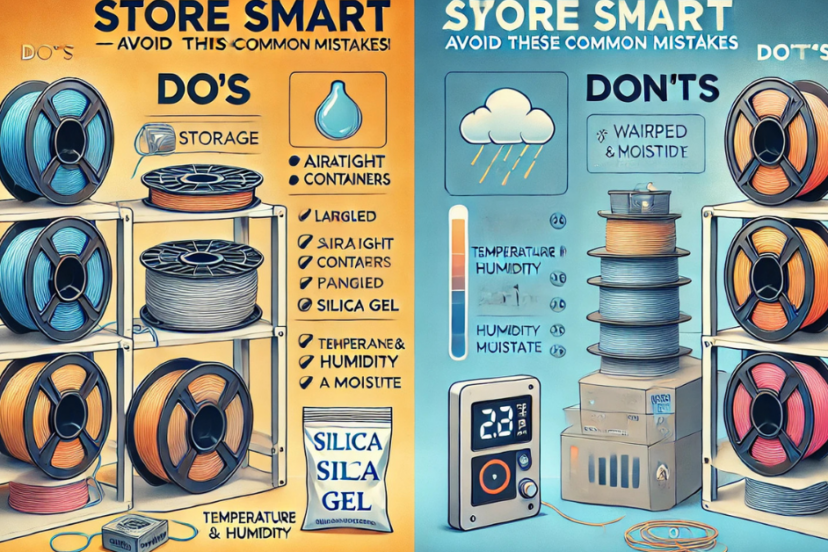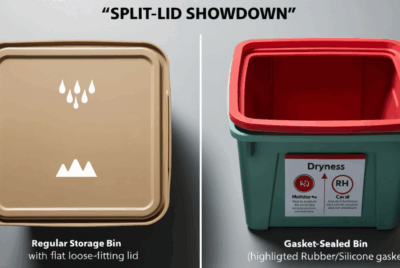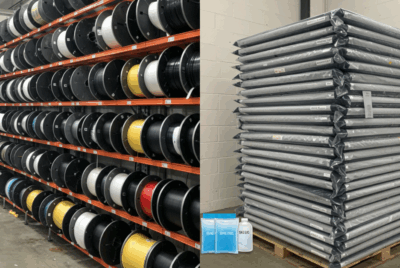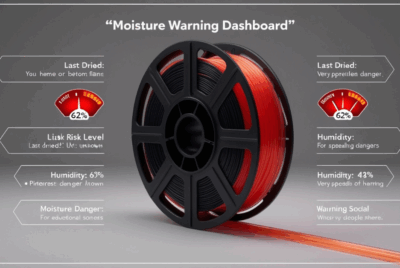How do I store filament long-term?
Storing 3D filament properly for the long term is important to keep it in optimal condition for printing. Filament can absorb moisture from the air, which can cause printing issues like bubbling, poor adhesion, and weak prints. Here are the best ways to store filament long-term:
1. Use Airtight Containers
- Method: Store your filament in airtight containers to protect it from moisture, dust, and other environmental factors.
- How to do it:
- Use large plastic bins with tight-fitting lids or dedicated filament storage boxes.
- Ensure the container is large enough to allow the filament spool to fit without getting crushed.
- For added protection, use a vacuum-seal container or bags.
- Benefits: Airtight containers prevent moisture from getting inside and maintain the filament’s integrity over time.
2. Store in Vacuum-Sealed Bags
- Method: Vacuum-sealing is one of the most effective ways to store filament long-term, as it removes air and moisture.
- How to do it:
- Place your filament spool in a vacuum-sealed bag with desiccants (silica gel, clay, or other moisture-absorbing products).
- Use a vacuum sealer to remove air from the bag and seal it tightly.
- Benefits: This method keeps filament dry and protected from humidity, especially in regions with high moisture levels.
3. Use Desiccants
- Method: Desiccants, such as silica gel or clay, help absorb moisture in your storage container or bag.|
- How to do it:
- Add desiccant packets to your airtight storage container or vacuum-sealed bag.
- Be sure to use enough desiccant to account for the size of the container and the moisture level in your area.
- Benefits: Desiccants ensure that the filament stays dry, especially if you don’t have access to a vacuum-sealed bag or container.
4. Store in a Cool, Dry Place
- Method: Keep filament in a climate-controlled environment with consistent temperature and low humidity.
- How to do it:
- Avoid storing filament in areas prone to temperature extremes or high humidity, such as garages, basements, or bathrooms.
- Ideal storage conditions are temperatures between 10°C and 25°C (50°F to 77°F) and humidity levels below 50%.
- Benefits: A stable, dry environment prevents moisture absorption and filament degradation.
5. Avoid Direct Sunlight
- Method: Keep filament away from direct sunlight, which can cause UV degradation, leading to brittleness and discoloration.
- How to do it:
- Store filament in opaque containers or bags that block sunlight.
- If using clear plastic storage boxes, keep them in a dark place or cover them to block out light.
- Benefits: This helps preserve the filament’s strength, color, and quality.
6. Organize by Filament Type and Color
- Method: Properly organizing your filament makes it easier to access and ensures that you’re using the right type of filament for your project.
- How to do it:
- Label each spool with its type (e.g., PLA, ABS, PETG) and color.
- Store different types of filament in separate containers to avoid confusion and ensure proper handling.
- Benefits: Organization helps maintain clarity and prevents accidental mixing of filament types, which could cause printing issues.
7. Use Filament Storage Dry Boxes
- Method: Filament dry boxes are specifically designed to keep filament dry during storage and printing.
- How to do it:
- Place the filament spool in a filament dry box, which usually includes built-in desiccants and humidity control features.
- Benefits: These boxes provide a stable, moisture-free environment and are especially useful for long-term storage.
8. Avoid Storing Filament in Extreme Heat
- Method: Keep filament away from areas with excessive heat, such as near radiators, stoves, or hot electronics.
- How to do it:
- Store filament in a well-ventilated area with moderate temperature levels, avoiding storage in places that can get too hot, like attics or close to heat sources.
- Benefits: Heat can cause the filament to soften or warp, making it difficult to use for future prints.
9. Regularly Inspect Your Filament
- Method: Check your filament occasionally for signs of damage or moisture absorption.
- How to do it:
- Look for brittleness, discoloration, or changes in texture. If the filament seems brittle, it may have absorbed moisture.
- You can dry filament that has absorbed moisture by placing it in a filament dryer or using an oven method.
- Benefits: Regular checks help ensure your filament is still in good condition and ready for use when needed.
By following these steps, you can store your filament long-term, ensuring it stays dry, protected, and ready for high-quality 3D printing whenever you need it!




